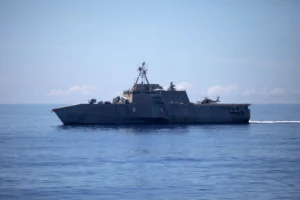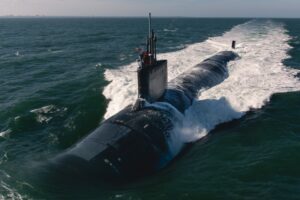The House Appropriations Committee’s (HAC) report on its draft of the fiscal year 2025 defense appropriations bill expressed severe displeasure with how the Navy is decommissioning Littoral Combat Ships (LCS) early and why it decided to maintain or cut Navy shipbuilding funding on various programs.
The first ship-based comment noted HAC is “incensed that, despite repeated rejections by Congress, the Navy is once again proposing to decommission several Independence Class Littoral Combat Ships (LCS) well before the end of their expected service lives.”

The Navy’s FY ‘25 budget request seeks to retire 10 ships earlier than planned, including the USS Jackson (LCS-6) and USS Montgomery (LCS-8).
The committee argued it “strongly believes” these ships can still provide operational value to the fleet, even if not aligned with the Navy’s original plan. It also said the Navy’s response to the committee’s concerns about LCS are viewed as “inadequate.”
“The Committee believes it is premature to divest these ships before the completion of a thorough assessment of the potential uses for these ships.”
HAC therefore directs the Navy Secretary to submit a report to the congressional defense committees on proposed alternative uses for the even-numbered Independence-variant LCSs within 30 days of the act’s enactment.
The 30-year shipbuilding plan explained these ships are excess to the Navy’s current LCS plan of 10 Freedom-variant LCSs dedicated to Surface Warfare missions and 15 Independence-variant LCSs dedicated to the mine countermeasures mission. LCS-6 and -8 were also originally designated to be surface warfare ships, but that task is only directed on the other LCS variant (Defense Daily, March 21).
The Navy has also argued it would take more funds and time to upgrade LCS-6 and -8 to current lethality and survivability systems but newer Independence-variant LCS are set to be delivered for surface warfare missions within the next five years.
The previous 30-year shipbuilding plan from FY ‘24 said the service planned to retire LCS-6 and -8 as well as the Freedom-variant ships USS Wichita (LCS-13), Billings (LCS-15), Indianapolis (LCS-17), and St. Louis (LCS-19) and set them all up for inactivation and categorized for potential Foreign Military Sales options (Defense Daily, April 20, 2023).
Separately, the committee noted that while it is “dismayed” by construction delays in the lead Columbia-class ballistic missile submarine (SSBN) and continued Virginia-class attack submarine (SSN) construction timeline challenges, keeping to the Navy’s single SSN procurement for FY ‘25 is the right call.
“Committee recommendation of one Virginia-class submarine, coupled with robust investment in the submarine industrial base, appropriately reflects the current capacity for submarine construction and deliberately targets funding to the industrial base to achieve long-term sustainable production,” the bill report said.
The HAC said significant continued investments in the Submarine Industrial Base (SIB) are needed to reach the planned 1 SSBN + 2 SSN production rates, so it recommends including $4 billion for the SIB, with $2 billion dedicated in the shipbuilding account.
This is a modest increase over the Navy’s request of $3.9 billion for the SIB in FY ‘25.

“The Committee believes investment in supplier capacity and capability, strategic domestic outsourcing, workforce development, and technology and infrastructure is key to achieving and sustaining the required submarine production cadence in the long-term and maintaining international commitments under the trilateral Australia, United Kingdom, United States (AUKUS) security partnership,” the report added.
The House Armed Services Committee disagreed and recommended shifting $1 billion into procuring a second Virginia-class submarine in FY ‘25, as the Navy previously planned.
The bill report explained while the committees differed on SSNs, they both agreed on cutting $1 billion to funding more Constellation-class frigates when the first ship is delayed at least three years.
“Despite findings in the 45-day Shipbuilding Review that show the Constellation-class frigate is at least three years behind schedule, the Navy continues to request funding to construct frigates at a rate that the program has demonstrated it is unable to meet. In addition to the delays found with lead-ship construction, the Committee notes the delivery dates for the three follow-on frigates currently under contract are unknown.”
The committee also said it is concerned by persistent design instability for the lead ship that could still impact construction. This comes after a recent Government Accountability Office report lambasted the Navy for frigate delays due in large part to significant design changes and delays to finalizing ship design (Defense Daily, May 29).
The committee also said while it supported the Marine Corps’ work on the Expeditionary Advanced Base Operations concept that spurred the Medium Landing Ship (LSM), it is concerned by the program’s requirements and design stability risks.
While the Navy sought $268 million for one LSM, the committee recommends providing only $30 million “to allow for the program to focus on achieving design stability and solidify requirements before making contractual commitment that funds construction of the lead ship.”
The report argued this cut and focus on design stability is because in previous programs the Navy underestimated requirements and design stability in lead ship construction, “resulting in significant cost increases, schedule delays, and instability in the shipbuilding industrial base.”
In April, the Congressional Budget Office released a report arguing the LSM will likely cost two to three times as much as the Navy currently estimates (Defense Daily, April 12).
The committee also said it is directing the Secretary of the Navy to submit a report to the appropriations committees on the Navy’s recommended actions following the secretary’s 45-day shipbuilding review that found significant construction delays in several shipbuilding programs (Defense Daily, April 3).
“Recognizing the importance of fleet capacity in power projection and the Chief of Naval Operations’ new force-level goal of 381 ships, the Committee is increasingly concerned by the long-term impacts of these delays.”
If approved, the report is due within 90 days of the bill being enacted.